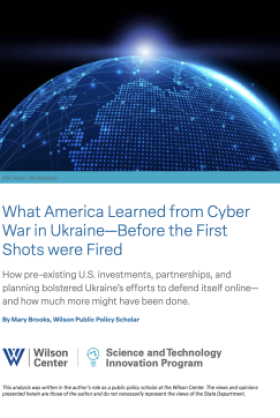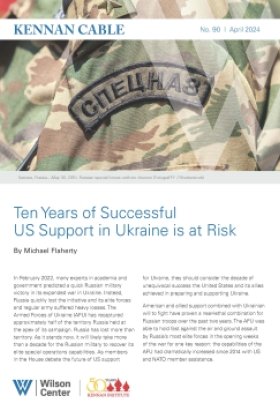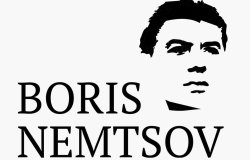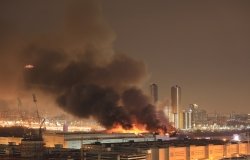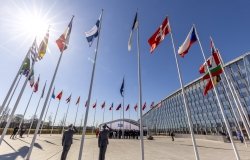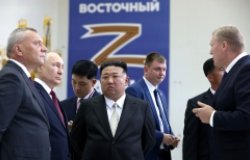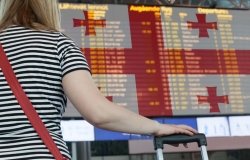DIRECTOR'S REVIEW: Music and Roses in the Air
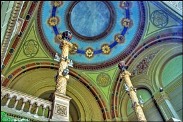 About three-quarters of the way into the evening's concert at Odesa's magnificent Neo-Moorish concert hall, Maestro Hobart Earle interrupted the Odessa Philharmonic Orchestra's annual City Day concert on September 2, 2008 to address the audience of more than 1,000 music lovers. The hall, which had been built at the end of the nineteenth century as the city's stock exchange, has provided a backdrop for far more brilliant musical performances over the years than human memory can retain. Earle, who has been the Orchestra's Music Director and Principle Conductor for nearly two decades, is himself as exotic as the hall and the city itself. An American raised in Venezuela, educated at Princeton and trained by Leonard Bernstein, Earle launched his music career in Vienna. As Gorbachevian perestroika took flight during the late 1980s, Earle joined an Austrian ensemble that toured the Soviet Union. Stopping in the charming port city of Odesa, Earle, in many ways, never has left. He assumed leadership of the struggling local orchestra and has built it into an internationally recognized master ensemble.
About three-quarters of the way into the evening's concert at Odesa's magnificent Neo-Moorish concert hall, Maestro Hobart Earle interrupted the Odessa Philharmonic Orchestra's annual City Day concert on September 2, 2008 to address the audience of more than 1,000 music lovers. The hall, which had been built at the end of the nineteenth century as the city's stock exchange, has provided a backdrop for far more brilliant musical performances over the years than human memory can retain. Earle, who has been the Orchestra's Music Director and Principle Conductor for nearly two decades, is himself as exotic as the hall and the city itself. An American raised in Venezuela, educated at Princeton and trained by Leonard Bernstein, Earle launched his music career in Vienna. As Gorbachevian perestroika took flight during the late 1980s, Earle joined an Austrian ensemble that toured the Soviet Union. Stopping in the charming port city of Odesa, Earle, in many ways, never has left. He assumed leadership of the struggling local orchestra and has built it into an internationally recognized master ensemble.
Earle's concerts marking the anniversary of Odesa's founding in 1794 have become legendary among the local cognoscenti. He carefully selects a range of music which represents the dozen nationalities that have made Odesa a wonderful city. On this evening, the orchestra played music by Russian composer Pyotr Tchaikovsky, Greek Nikos Skalkattos, Georgian Sulkhan Tsintsadze, Italian Gioacchino Rossini, Frenchman George Bizet, and Armenian Aram Khachaturian to pay homage to the contributions each national group has made to Odesan life. Similarly, Myroslav Skoryk's Melody for Strings and Mykola Lyssenko's rousing overture to Taras Bulba stood for Ukraine, while a stirring medley combining Hava Nagila with music from The Fiddler on the Roof honored the vibrant Jewish elements of Odesan history. Earle dedicated the concert to the City of New Orleans with a Blues written for orchestra by his mentor Leonard Bernstein, observing the suffering of the city inflicted by Hurricane Katrina three years before. He did so as Hurricane Gustav roared ashore a-third-of-the-way around the world.
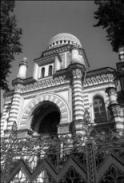 When Earle put down his baton and turned to address the crowd in his beautiful Russian, he paid homage to cultural diversity in a different way. He spoke of the enormous contributions to Odesa and Ukraine of the work by an American scholar who labored away in distant archives throughout the 1970s and 1980s to write a history of Odesa which no one in the city could have written. He spoke of the critical importance that scholar's work has played in allowing Odesa to recover its history following the forced amnesia of the Soviet period. He spoke of the special role scholars can play in preserving the history of others.
When Earle put down his baton and turned to address the crowd in his beautiful Russian, he paid homage to cultural diversity in a different way. He spoke of the enormous contributions to Odesa and Ukraine of the work by an American scholar who labored away in distant archives throughout the 1970s and 1980s to write a history of Odesa which no one in the city could have written. He spoke of the critical importance that scholar's work has played in allowing Odesa to recover its history following the forced amnesia of the Soviet period. He spoke of the special role scholars can play in preserving the history of others.
As Earle spoke, a spotlight focused on a grey haired grandmotherly woman in the center of the Hall. Patricia Herlihy, Professor Emeritus of Brown University, is all that Maestro Earle declared her to be. Her history of Odesa, recently published in Russian, has become a core text for anyone who wants to study the complex and rich story of a city that has enriched Russian, Jewish, Ukrainian, and world culture. As Herlihy stood to acknowledge the applause and cheers of those in the room, ushers rushed forward with an armful of roses presented by Odesans as thanks for all that she has done for their city.
Every scholar probably dreams in some way of just such a moment, yet most understand that such recognition is rare. Scholars – including Patricia Herlihy, who is a former Kennan Institute scholar and a continuing advisor on many of our councils – have learned to work in obscurity. They change the world quietly, reader by reader and student by student. Their ideas enter into the world silently until, at some moment, a reader who can be distant in time and space learns from those ideas and changes the world. Patricia Herlihy's intellectual voyage is unusual only in that she has had the opportunity to have those invisible readers become tangible in a concert hall in Odesa on a beautiful and gentle late summer's eve.
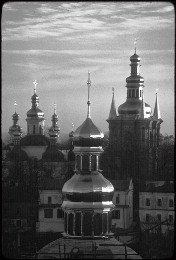 Patricia Herlihy's scholarship has changed how Odesans think of their city, just as the work of many other historians change how all of us see the world. Their impact does not always appear in flow charts and institutional accounts of success. A calculation of the number of times that their works have been cited in distinguished journals only begins to capture their impact. Like Patricia Herlihy herself, scholars toil away in obscurity, digging through archives or collecting survey data, compiling and analyzing, and bringing their insights into life through a myriad of publications both obscure and merely underappreciated. Russian scholars tell us about a United States we ourselves never see; Americans offer insights into Ukraine which Ukrainians would otherwise never know, and so on and so forth. It is the work of Patricia Herlihy—and the more than twelve hundred scholars like her who have worked at the Kennan Institute—that represents the true measure of this institution's contribution over the years.
Patricia Herlihy's scholarship has changed how Odesans think of their city, just as the work of many other historians change how all of us see the world. Their impact does not always appear in flow charts and institutional accounts of success. A calculation of the number of times that their works have been cited in distinguished journals only begins to capture their impact. Like Patricia Herlihy herself, scholars toil away in obscurity, digging through archives or collecting survey data, compiling and analyzing, and bringing their insights into life through a myriad of publications both obscure and merely underappreciated. Russian scholars tell us about a United States we ourselves never see; Americans offer insights into Ukraine which Ukrainians would otherwise never know, and so on and so forth. It is the work of Patricia Herlihy—and the more than twelve hundred scholars like her who have worked at the Kennan Institute—that represents the true measure of this institution's contribution over the years.
Just in the past twelve months, the Kennan Institute has hosted 71 scholars who have explored the post-Soviet space, assessed the legacies of both Soviet rule and the Russian Empire, and identified prospects for the future through the study of a highly diverse range of topics. Long-term scholars such as Nadezhda Aydayeva, Alexander Duka, Petr Panov, and Scott Radnitz scrutinized domestic politics in Russia and surrounding states, on both the elite and mass levels, to uncover the dynamics behind governmental public relations and political communication, the institutionalization of power elites, elections, and mass mobilization and networks. Alexander Petrov breached the realm of international politics and provided an historical perspective of the relationship between the United States and Russia through his study of the beginning of Russian-American relations 200 years ago. Other scholars such as Vitaliy Zhuhay and Ildar Zulkarnay turned their scholarly gazes toward the U.S., looking at local media and how informal institutions effect formal institutions of self-government in the U.S.
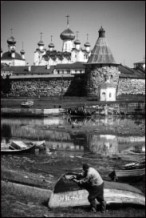 Andrey Rezaev brought a similar comparative perspective when he looked at the educational and social experiences of transnational migrants in St. Petersburg and Washington, D.C. Migration is an especially pressing issue for the countries of the former Soviet Union, where large-scale international migration is a relatively new phenomenon. Rezaev's research project, along with Dmitry Dubrovskiy's investigation of the institutionalized tools of discrimination in Russia and Leyla Keough's study of the woman migrant's experience in post-socialist Europe, continues the ongoing work of the Kennan Institute to elucidate the growing policy ramifications of migration and tolerance in the post-Soviet space.
Andrey Rezaev brought a similar comparative perspective when he looked at the educational and social experiences of transnational migrants in St. Petersburg and Washington, D.C. Migration is an especially pressing issue for the countries of the former Soviet Union, where large-scale international migration is a relatively new phenomenon. Rezaev's research project, along with Dmitry Dubrovskiy's investigation of the institutionalized tools of discrimination in Russia and Leyla Keough's study of the woman migrant's experience in post-socialist Europe, continues the ongoing work of the Kennan Institute to elucidate the growing policy ramifications of migration and tolerance in the post-Soviet space.
As several of our scholars this past year have demonstrated, the study of religion, in its institutional, conceptual, and practical manifestations, provides cross-cutting perspective that reveals how identity and diversity affect politics and society. Irina Garri, for example, compared the impact of Buddhism on politics in Russia with its impact in China. Chingiz Mammadov seized upon the opportunity offered by the experience of interfaith and interethnic tolerance in Azerbaijan to suggest how current religious and ethnic tension in Iraq might be moderated. Alexander Knysh mounted a historical study of the encounter between an expanding Russian Empire and the Muslim population of the Northern Caucasus of the 19th century to challenge ongoing stereotypes about Muslim resistance in these areas today. Jacques Levesque considered the role of Islam in contemporary Russian politics through a closer study of the Chechen wars.
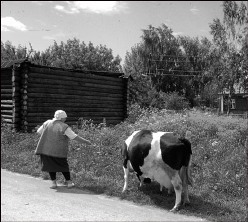 In reflecting upon the historical and cultural legacies of Russia and its surrounding areas, Knysh, along with several other Kennan Institute scholars this past year, has achieved the Institute's continuous objective of placing issues into their larger context, creating room—in a city preoccupied with immediate policy concerns—for longer-term perspective. Although dealing with different historical periods, Eugene Avrutin, through his study of identification politics and Jewish accommodation in Imperial Russia, and Kate Brown, through her study of the history of the Chernobyl Zone, uncovered larger issues about power, identity and the control of space and movement. Vladyslav Grynevych assessed the Second World War and the Holocaust in the historical memory of Jews and Ukrainians. Elena Yushkova evaluated the influence of Isadora Duncan on Russian art and Russian mentality, and organized a special seminar for the Kennan Institute that highlighted Duncan's modern dance methods.
In reflecting upon the historical and cultural legacies of Russia and its surrounding areas, Knysh, along with several other Kennan Institute scholars this past year, has achieved the Institute's continuous objective of placing issues into their larger context, creating room—in a city preoccupied with immediate policy concerns—for longer-term perspective. Although dealing with different historical periods, Eugene Avrutin, through his study of identification politics and Jewish accommodation in Imperial Russia, and Kate Brown, through her study of the history of the Chernobyl Zone, uncovered larger issues about power, identity and the control of space and movement. Vladyslav Grynevych assessed the Second World War and the Holocaust in the historical memory of Jews and Ukrainians. Elena Yushkova evaluated the influence of Isadora Duncan on Russian art and Russian mentality, and organized a special seminar for the Kennan Institute that highlighted Duncan's modern dance methods.
In addition to this remarkable array of scholars who have enriched the intellectual vitality of the Kennan Institute this past year, the Institute is proud to continue to host four remarkable scholars engaged in some of the most crucial research topics for the former Soviet area. Murray Feshbach continues to consider the policy implications of population, health, and environmental trends in Russia. Alexandra Vacroux's work reveals institutional obstacles of the Russian state through assessing failed healthcare reform in Russia. Jan Kalicki continues to evaluate energy and security issues and opportunities in Russia and its surrounding states, while Ambassador William Green Miller works toward providing understanding for the evolving U.S.-Ukraine relationship.
 The Kennan Institute also welcomes an impressive list of new scholars. Currently, Darima Amogolonova examines the challenges that globalization poses on Siberian ethnic elites; Melanie Feakins monitors the expansion of St. Petersburg and its effects on its inhabitants; Cynthia Hooper researches historical instances of collaboration and coercion in the Soviet system; Roman Kalytchak looks for lessons for Ukraine in U.S. federal and state relationships in international affairs; Volodymyr Kulyk appraises language, identity, and democracy in post-Soviet Ukraine; Natalia Nikitenko works to reconcile the incompatibility between national interests and international law standards regarding human rights and justice; Yuriy Nosik considers the concept of trade secrets at the turning point of intellectual property law theory; Gül Berna Özcan studies the control of markets and governance through strategic assets in Central Asia; Tatiana Riabova observes gender in the political discourse of contemporary Russia; and Vladislav Zubok assesses the generation of Russian intelligentsia after Stalin. The Kennan Institute looks forward to the results of these various studies.
The Kennan Institute also welcomes an impressive list of new scholars. Currently, Darima Amogolonova examines the challenges that globalization poses on Siberian ethnic elites; Melanie Feakins monitors the expansion of St. Petersburg and its effects on its inhabitants; Cynthia Hooper researches historical instances of collaboration and coercion in the Soviet system; Roman Kalytchak looks for lessons for Ukraine in U.S. federal and state relationships in international affairs; Volodymyr Kulyk appraises language, identity, and democracy in post-Soviet Ukraine; Natalia Nikitenko works to reconcile the incompatibility between national interests and international law standards regarding human rights and justice; Yuriy Nosik considers the concept of trade secrets at the turning point of intellectual property law theory; Gül Berna Özcan studies the control of markets and governance through strategic assets in Central Asia; Tatiana Riabova observes gender in the political discourse of contemporary Russia; and Vladislav Zubok assesses the generation of Russian intelligentsia after Stalin. The Kennan Institute looks forward to the results of these various studies.
Few, if any, of the 32 long-term and 39 short-term scholars who have worked at the Kennan Institute during the past year are ever likely to bring a concert by a major symphony orchestra to a halt. Most, if not all, will change the world around them in positive, if not always visible ways. The accomplishment of the Kennan Institute this past year—as during each of the 34 years that have come before—has been to help make such scholarship possible, and to bring it to the attention of people who otherwise would never know of its existence. Like Maestro Earle, our task is to be sure that ideas which can change our understanding of the world can take flight.
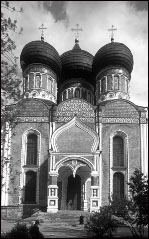 In closing I would like to make special note of the Kennan Institute staff in Washington, Moscow, and Kyiv, without whom none of the accomplishments contained in this report would have been possible. I have had the incommensurable good fortune of working with a group of individuals over the past year that has consistently set a high standard to which I can only aspire. Ekaterina Alekseeva, Edmita Bulota, Joseph Dresen, Renata Kosc-Harmatiy, Sarah Dixon Klump, Pavel Korolev, Edita Krunkaityte, Galina Levina, Rachel Madenyika, Mary Elizabeth Malinkin, Margaret Paxson, Irina Petrova, William Pomeranz, Yaroslav Pylynskyi, Maryna Rosinska, Nataliya Samozvanova, Anna Toker, S. Todd Weinberg, and Lidiya Zubytska have been true colleagues. Markian Dobczansky and Megan Yasenchak, who left the Institute this past year, are already being missed. I value deeply their collective and individual intelligence, imagination, integrity, and good cheer. All who care about the Kennan Institute are in their debt.
In closing I would like to make special note of the Kennan Institute staff in Washington, Moscow, and Kyiv, without whom none of the accomplishments contained in this report would have been possible. I have had the incommensurable good fortune of working with a group of individuals over the past year that has consistently set a high standard to which I can only aspire. Ekaterina Alekseeva, Edmita Bulota, Joseph Dresen, Renata Kosc-Harmatiy, Sarah Dixon Klump, Pavel Korolev, Edita Krunkaityte, Galina Levina, Rachel Madenyika, Mary Elizabeth Malinkin, Margaret Paxson, Irina Petrova, William Pomeranz, Yaroslav Pylynskyi, Maryna Rosinska, Nataliya Samozvanova, Anna Toker, S. Todd Weinberg, and Lidiya Zubytska have been true colleagues. Markian Dobczansky and Megan Yasenchak, who left the Institute this past year, are already being missed. I value deeply their collective and individual intelligence, imagination, integrity, and good cheer. All who care about the Kennan Institute are in their debt.
Blair A. Ruble
October 1, 2008
Related Program

Kennan Institute
The Kennan Institute is the premier US center for advanced research on Russia and Eurasia and the oldest and largest regional program at the Woodrow Wilson International Center for Scholars. The Kennan Institute is committed to improving American understanding of Russia, Ukraine, Central Asia, the Caucasus, and the surrounding region though research and exchange. Read more

